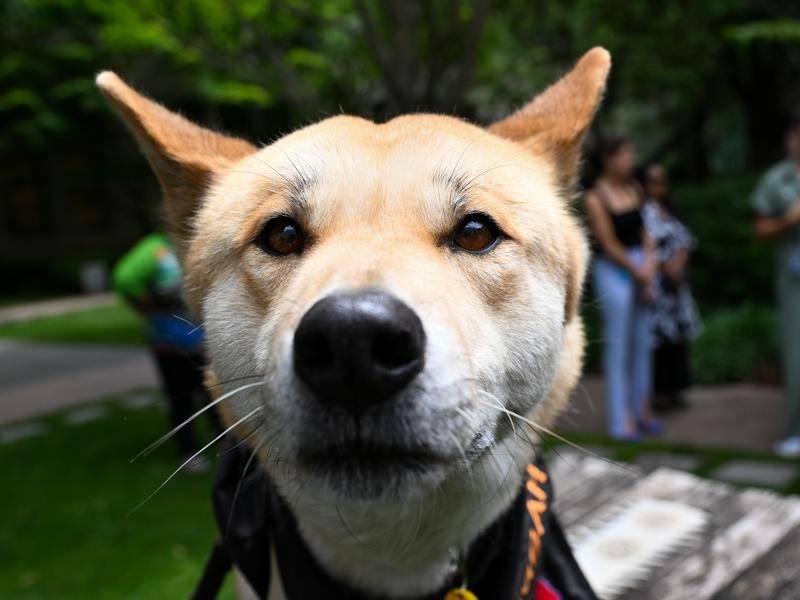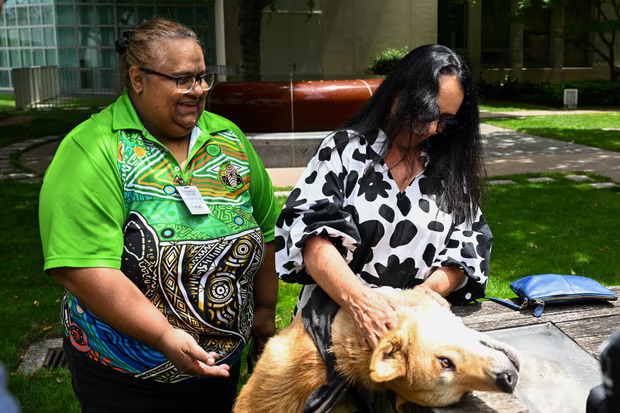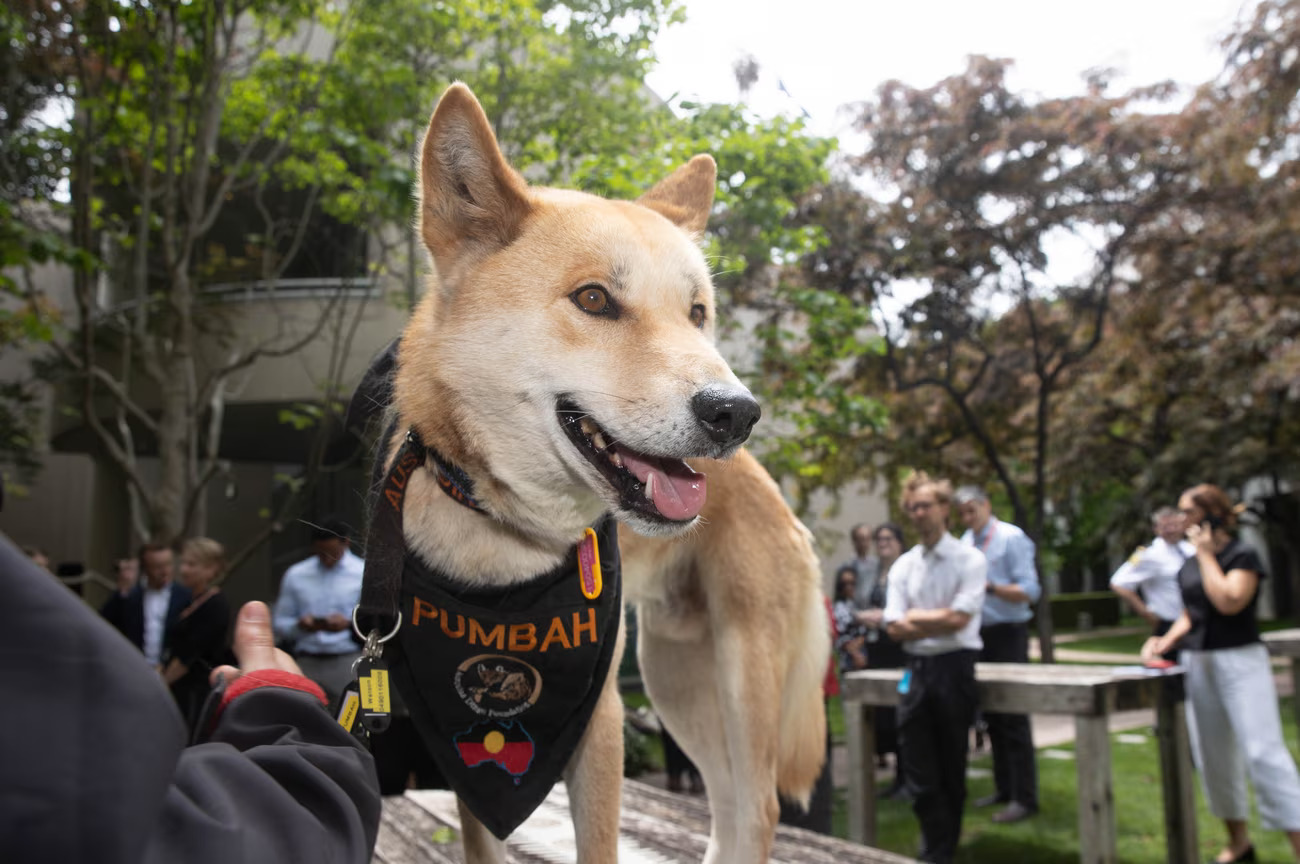Dingo lovers seek a political response to new understanding of a carnivore considered kin by First Nations people and villain by many farmers
A dingo called Pumbah entered Australian parliament this week in an effort to persuade the country’s lawmakers they have been persecuting his species based upon a myth and mistruth.
Pumbah, who journeyed from the foothills of Victoria’s Macedon Ranges, was ushered through a side entrance to parliament on Thursday while a group of his human allies strode through the main foyer. Scientists, Indigenous people and lifelong dingo warriors, they travelled from opposite ends of the continent, from far north Queensland, through coastal New South Wales and central Victoria to be there.
“This is momentous for us,” the Australian Dingo Foundation director, Mel Browning, said.
Browning not only proclaimed Pumbah the first dingo in parliament, but the moment as another step in the radical reimagining of Australia’s largest land-based predator.
In May, DNA analysis led by the University of NSW’s Dr Kylie Cairns upended the widely held belief that most “wild dogs” roaming the continent were dog-dingo hybrids, finding instead that the majority are pure dingoes.

‘We are going to have to learn, sooner or later, how to coexist with nature and with animals’ … Pumbah, an alpine dingo, visits Parliament House in Canberra.
Now, dingo lovers Australia wide are seeking a political response to our updated understanding of a carnivore considered kin by First Nations people, and villain by many farmers.
In September, a group of scientists petitioned state governments to stop using the “inappropriate and misleading” term “wild dog” and end baiting programs aimed at destroying the native species in national parks.
Sonya Takau, a Jirrbal rainforest woman from Tully, was a driving force behind the First Nations forum. She grew up with a dingo and now has another in her care – a black and tan rainforest dingo called Bina – in defiance of Queensland law which forbids it.
That state’s laws exemplify the seemingly irreconcilable contradictions which dog the dingo.
On one hand is Queensland’s Nature Conservation Act 1992, which defines the dingo as “native wildlife”. Under its Biosecurity Act 2014, however, it is defined as a “restricted invasive animal” – a designation which confers upon landowners a “general biosecurity obligation (GBO)” to “manage” dingoes using methods “including shooting, poisoning [and] trapping”. In some states, there are no protections afforded to dingoes, even in conservation areas.
“First Nations people across Australia, and I know personally with my own self, I have a GCO, a general cultural obligation, to protect these animals,” Takau, who travelled to Canberra this week, says.
“They are family to my people.”

Despite dingoes having been “entwined so strongly” through the strands of her life since childhood, the term wild dog was not one she had heard of until she learned about what was being done to wild canids in other parts of Australia.
“All along the white man has been telling people in this country that there are no pure dingoes any more,” she says. “Purity has got nothing to do with it. If it looks like a dingo and acts like a dingo, then it’s a bloody dingo.”
Takau says the term “wild dog” has wrought “so much damage to dingoes in this country”.
“And it’s not true,” she says. “Kylie [Cairns] has debunked that. What Aboriginal people have been saying orally, all along, has now been proven through western science.”
Cairns was there in parliament on Thursday too – the population geneticist says she drove to Canberra from the NSW central coast to “witness history”.
“This is a pretty significant moment,” she says. “The information that we thought we knew about dingoes in the wild has basically been transformed.”
Until recently, Cairns says, scientists used to think that there was widespread hybridisation of canids going on that was “potentially going to drive dingoes to extinction in parts of Australia”.
Cairns says that her recent study, which found that 69% of wild dingoes are “pure” rather than hybrid, also discovered those that do have dog ancestry “don’t have as much as we thought”.
She says that it built upon a wealth of DNA studies that prove “that feral dogs do not persist in the wild in Australia”.
Despite the “transformative body of evidence”, Cairns says it could be difficult to overcome the widely held notion that feral dogs roam the bush in Australia while dingoes are confined to places like K’gari.
She believes that is due to an underappreciation of the diversity of dingo varieties, some of which may be black and tan, white or sable, or look “vaguely German shepherd-ish”.
“Sometimes dingoes don’t look ‘the typical dingo’,” she says.
“What I think has happened is that people have seen those animals and have been told, in the past, that it was because of hybridisation,” she says. “And now we have learned that that’s not true.”
The reaction from some state governments to her research has not been “as constructive as could have been”, Cairns says, while others have shown downright reluctance to engage in the politically charged topic of wild canids.
“It is quite a dramatic shift and it is taking quite some time for government and policymakers to come to terms with it and consider how they are going to proceed,” she says.
“At the same time the science is not being challenged.”

Faced with the inertia of state and territory governments who are largely responsible for dingo policy, the advocates want Canberra to take a leadership role, adopting a national strategy that would direct public money away from killing dingoes and invest instead in living with them.
To do so, they would have to completely turn around deeply emotive and established views about dingoes from the livestock industry.
The current National Wild Dog Action Plan says it applies to “all wild-living dogs, which include: dingoes, feral dogs and their hybrids”. It describes wild dogs as an existential threat to the sheep and goat industry and one that inflicts “serious emotional and psychological damage to landholders and their families”.

Dr Barry Traill, who emceed Pumbah’s event on Thursday, helped set up Landholders for Dingoes, connecting farmers around the country who are bucking the trend and embracing dingoes on their land.
“These are cattlemen who independently came to the same realisation that they were better off with dingoes,” the zoologist says.
Traill says dingoes could eradicate feral goats from most landscapes and prevent overgrazing by kangaroos, which means both healthier country and more grass in the paddocks for livestock.
While he acknowledges that “dingoes in paddock with sheep and goats don’t work”, those livestock could be protected from dingoes using nonlethal methods such as guardian dogs and donkeys.
But he says the focus of government and industry investment over more than 150 years has been on a policy of eradication, rather than on supporting farmers to protect their livestock without killing wild canids.
“It all got very confused,” he says. “It’s clear now: domestic dogs don’t go feral.”
Takau says that clarity should make Australians stop and “take a really good look in the mirror”.
“That word coexistence, that’s not going to go away, because we are going to have to learn, sooner or later, how to coexist with nature and with animals,” she says.
“Aboriginal people have been doing it a long, long time.”

Whoa! This blog looks just like my old one!
It’s on a entirely different topic but it has pretty much the same
layout and design. Great choice of colors!